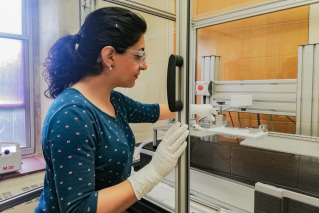Physics professor authors tutorial to introduce polymer researchers to neutron scattering spectroscopy

August 6, 2020
Polymers are found throughout our world. In numerous ways, they benefit society, most visibly as exercise clothing, personal protective equipment, or medical devices. At the same time, polymers are also the plastic water bottles polluting the ocean and microplastics in our water streams.
Creating sustainable polymers remains an ultimate pursuit for many scientists and engineers in this space. In order to engineer better polymers, Virginia Tech professor Rana Ashkar said researchers need a deeper level of knowledge of the polymer structure-property-function relationships.
To this end, Ashkar, an assistant professor of physics, has been actively engaged in introducing polymer researchers and students to neutron scattering spectroscopy methods through research papers, focused tutorials, workshops, and summer schools. This unique technique allows scientists the ability to selectively view different aspects of a polymer sample, on the nanoscale, to better understand structure-property-function relationships.
"If we are going to work with sustainable materials, we'd better understand how they age and what type of dynamics govern their function," Ashkar said. "This is what will allow engineers and materials scientists to develop materials that have advanced properties or that are more sustainable than others."
An accessible tutorial for students and faculty
Ashkar is affiliated with the Macromolecules Innovation Institute (MII), a Virginia Tech polymer research center. Although her lab activities include elements of polymer research, her current research focuses are on understanding the complex structures, dynamics, and functions of biomimetic membranes.
Ashkar's recent tutorial on neutron scattering spectroscopy, featured in the Journal of Applied Physics, focuses on studying polymer composites, which are complex materials featuring polymer functionalized nanoparticles that can impart advanced functionality to regular plastics.
"There's only a small community that uses neutron scattering spectroscopy, so it feels like a magic box that is not accessible to a lot of people," Ashkar said.
The purpose of the tutorial was to make the technique more accessible and illustrate its use in a variety of polymeric systems.
Tim Long, the former director of MII, said the neutron scattering spectroscopy tutorial and Ashkar's expertise will elevate macromolecular science and engineering research across Virginia Tech.
"Dr. Ashkar offers a bold vision involving the fundamental understanding of molecular dynamics across many length scales from the nanometer to the millimeter, and her unique perspective will have profound implications on the future design of advanced polymeric materials," Long said. "Materials are constantly moving although they appear as solids, and these molecular dynamics dictate properties ranging from the adhesion mechanism of bacterial cells on surfaces to the impact performance of aerospace vehicles."
Selective viewing enabled through neutron scattering spectroscopy
Neutron scattering spectroscopy is not as widely used as X-ray spectroscopy, but Ashkar sees the two as complementary techniques. Although X-rays are useful, they are energetic and can easily cause radiation damage to polymers. Neutrons, on the other hand, are benign.
One of the weaknesses of X-ray spectroscopy is that X-rays are inherently sensitive to heavier elements. For example, in a composite material containing silica nanoparticles, a fairly common example of a polymer nanocomposite, the signal from silica dominates the scattering and overshadows the polymer components, typically composed of lighter elements such as hydrogen, carbon, and oxygen.
But neutron scattering is different. Ashkar said neutrons are sensitive to the nuclear structure of the sample, and by substituting the hydrogen atoms for deuterium, a hydrogen isotope with one neutron, scientists are able to view the polymer elements more clearly and selectively.
Ashkar used an anlogy of two Pyrex glass straws, one partially submerged in vegetable oil and another in water. To the naked eye, the straw "disappears" in the oil but can still be seen in water.
In reality, the Pyrex straw and the vegetable oil have a matching index of light refraction, a measure of how quickly light moves through materials. In a similar way, isotope labeling in neutron scattering aims to partially "hide" parts of a polymer structure in order to selectively view different elements.
"We use similar tricks with neutrons but on a molecular level," Ashkar said. "Using isotope labeling, we can change how we see molecules on the nanoscale. This is what allows us to selectively study certain features in a polymeric system while masking others."


